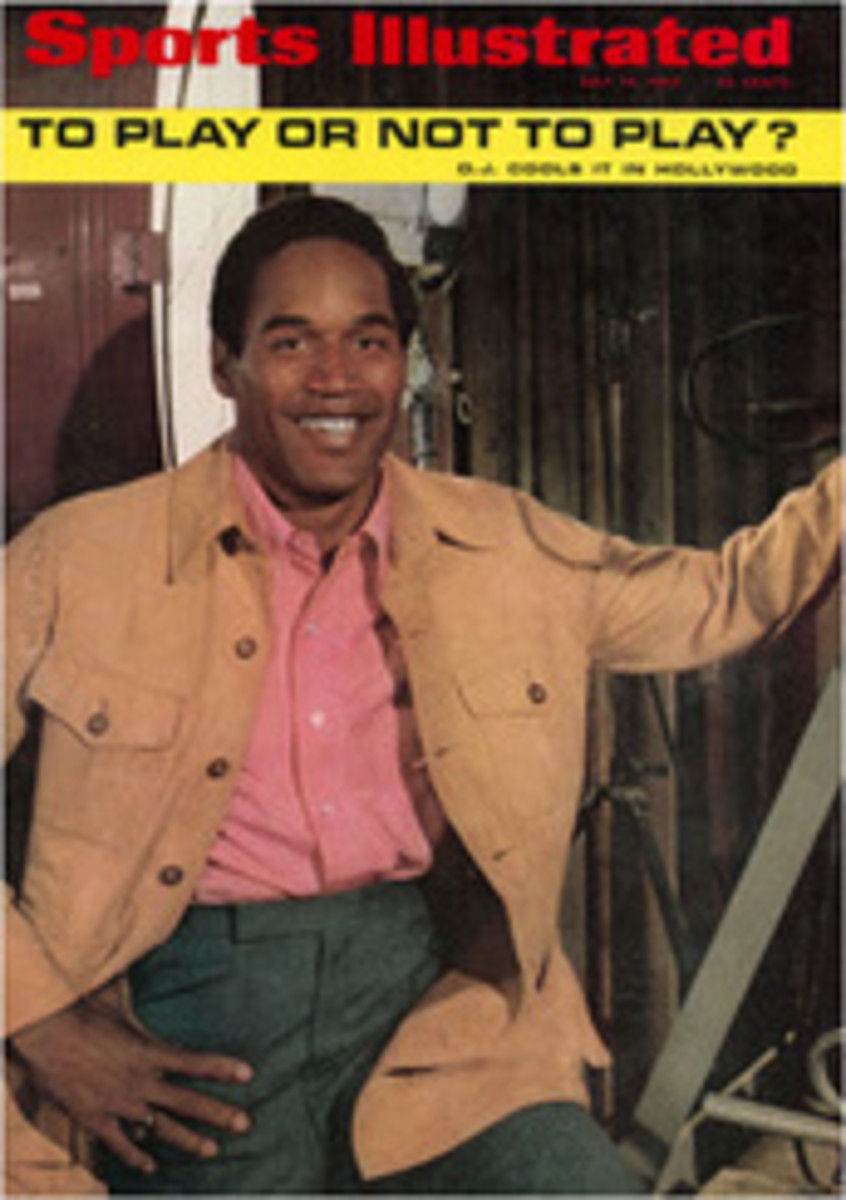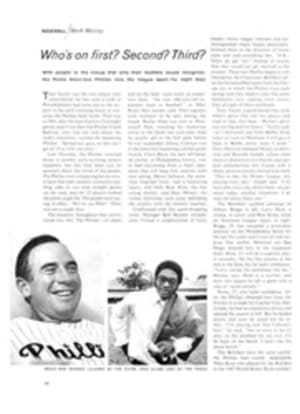
NATURAL ENEMY OF WILD CATS
The mortal enemy of wild cats—all wild cats, but especially the leopard, the jaguar and the cheetah—is rich women. This fact was established, none too politely, at an international conference on game conservation held in Monaco last year. At least a quarter of the women present were adorned with some form of wild cat. Princess Grace did leave her leopard coat back at the palace but turned up wearing a belt of cat's claws under her mink.
Outraged at the display and undaunted by the presence of royalty, Tony Dyer, president of the East African Professional Hunters Association, exhorted the ladies: "Hide your coats! All you out there in suits and dresses and articles made of the very animals we are trying to preserve! Take them off and throw them away."
Jacques Kaplan, chairman of the board of Georges Kaplan, Paris and New York house of high fur fashion, went Dyer one better. He ran a four-column ad in The New York Times which began, "If you respect life, wait 20 years before you buy your next leopard coat from us," and proceeded to announce his refusal to sell any more leopard and cheetah coats.
In spite of such dramatic pleas, it is doubtful that very many spotted furs were tossed into trash cans or that those ladies with their hearts set on leopard were unable to find another furrier. But when the second International Big Game Hunters and Fishermen Conference was held recently in San Antonio, there was a noticeable absence of wild-animal skins in the audience. A way-out array of non-wild, nonendangered skins had replaced them, and a smile had replaced the frown on Tony Dyer's face.
The concern of Dyer and Kaplan and most conservationists for the big cats is not without cause. For more than a decade the wild cats of the world have been having a rough time of it. Encroaching civilization is partly at fault, of course, but neither civilization nor sports hunting can be blamed for more than a small share of the kill. The single most formidable threat to the survival of the cats, as well as to the survival of a number of other wild creatures, is posed by the women who create the demand for skins and thus keep poachers in business.
With the exception of one tiger-skin jacket and an odd stole or two, it is doubtful that the animals used to make any of the various coats, jackets, hats, handbags and bits of jewelry worn at the Monaco conference were taken on actual hunts under sporting conditions. More likely, these animals, along with the leopard, cheetah, ocelot and jaguar skins displayed in the windows of even the most circumspect furrier, were taken illegally, and indiscriminately, by poachers.
A leopard coat requires the carefully matched skins of five to seven animals. Few sportsmen can claim five or six leopards even in a lifetime of hunting, much less animals with matching skins. There are a few—very few—commercial ranchers now raising various big cats for the fur market, but even if their total production were 10 times what it is, they could not begin to meet the current demand for skins. And the demand has rocketed in the last several years, thanks to such luminaries as Barbra Streisand and the new Mrs. Onassis and the former Miss Kelly, all of whom have made spotted coats the tie plus ultra of haute couture.
In the city of Nairobi alone some 1,200 leopard and cheetah skins were sold on the open market in 1967. Last year that figure soared to 5,000 skins and the total will go even higher when sales for the final weeks in 1968 are tallied. The total number of leopards taken in Kenya by sportsmen hunting on licenses—the proceeds of which go directly back into game conservation—was only 1/100 of the number of leopard skins sold during the same period.
It is obvious that the animals, the government and the sportsmen are all losers, and that they will continue to be as long as poaching is profitable. At the moment, alas, it is very profitable indeed. It is, in fact, the single most lucrative and thriving underground business in every area where the big cats still survive. Nor is the problem limited just to cats. Wherever there are wild creatures unfortunate enough to grow hides or hair or wool or whiskers that women covet, poaching becomes a major destructive force.
Widespread efforts have been made to eliminate or at least reduce poaching in many parts of the world—in Florida where illegal alligator trade is rife, in South America where the vicu√±a is the victim, throughout the far-flung ranges of the big cats—but most efforts have failed. For every poacher who is caught and put out of business, there are 10 more ready to take over his trade.
The fact that leopard coats currently sell for as high as $20,000 has been no deterrent for the ladies. For the poacher it is a major incentive. And for the leopard it means oblivion. The effect is circular: the scarcer the skin, the greater the demand; the greater the demand, the higher the price; the higher the price, the heavier the poaching activity; the heavier the poaching activity, the scarcer the skin.
"One solution," says Jacques Kaplan, "is to put every woman in spots." This is not by any means an about-face by Kaplan, whose stand on the side of the big cats drew some 20,000 letters of praise from the public and some multi-barreled blasts from other furriers. ("To put it mildly," says one Kaplan employee, "the other furriers sort of like hated our guts!") Rather, Kaplan has been hard at work developing new furs from domestically bred or plentiful animals which can be dyed and stenciled to duplicate the look and feel of cat fur.
Unlike Kaplan's informal showing of fun furs at the San Antonio conference—which featured such unendangered but spotless exotica as ermine, mink, golden Ethiopian monkey, gray African kid and Mongolian lamb—his next major showing, in September, will be entirely of spotted furs, not one of which is wild. According to Kaplan, his new pseudo-spots are so realistic they would fool even a leopard. At $800 to $1,000, their price tags are as realistically cool as the cats.
Kaplan's idea is one way to take pressure off wild cats. Another is action at government level. Most of the countries, including our own, that produce or trade in cat skins have been notoriously negligent about import-export regulations. In most cases it has been easier to look the other way than to take on a powerful and articulate fur lobby. But, first at Monaco and again at San Antonio, Game Conservation International, the nucleus of both conferences, has demonstrated that it, too, has a voice.
It was heard early this year, in the form of a cable to the heads of governments all over the world, outlining a six-point program to fight poaching of the big cats. Basically the program urges that: 1) the feline-skin trade in each supplying country be funneled through a single channel in that country; 2) profits from that channel be returned directly to wildlife management authorities of the countries; 3) individual furriers in all countries declare and mark their entire stocks of cat skins and products within a prescribed amnesty period; 4) cat-producing countries stop the import of feline skins and products into their countries, thus making the import and re-export of illegal skins impossible; 5) an advertising campaign be undertaken throughout the world aimed at discouraging the manufacture of articles made of cat skins and products; and 6) every hunter, and especially every hunter's wife, begin a personal campaign to stop the practice of using feline skins and products for decorations and clothing.
Similar proposals recommending trade bans on other endangered animals were sent to the governments of Argentina, Chile, Bolivia, Peru, Portugal, Belgium, France, China, the Soviet Union and the Tadzhik Soviet Socialist Republic. Exactly how closely even the most cooperative governments will listen to the recommendations of the council remains to be seen. But there was no question in the minds of the delegates as to the potential of the voice that was heard at the Texas meeting. What began only three years ago as the soft-spoken dream of a Texan named Harry Tennison and grew less than a year later into Game Conservation International—better known as Game Coin—drew some 900 delegates from 53 countries to San, Antonio and gave every indication of fast becoming a most vital and vibrant champion of the world's wildlife. Clearly it had already challenged the ladies in its midst and won. And if the ladies will listen, can the governments be far behind?
PHOTO
PHILLIP LEONIAN
AS A SYMBOL of woman's fascination for feline furs, Alberta Tiburzi, swathed in Siamese leopard, poses against a zebra-skin backdrop in Jacques Kaplan's New York apartment. She is surrounded by borrowed rugs, throws, pillows and accessories made from the skins of tiger, ocelot, jaguar and cheetah.

